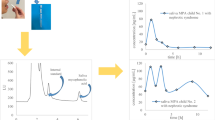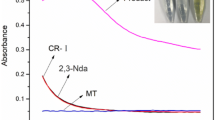Abstract
The enzymatic system in saliva, consisting of salivary peroxidase (SPO), hydrogen peroxide (H2O2), and thiocyanate (SCN−), produces hypothiocyanite (OSCN−) as a high effective antibacterial compound. OSCN− is of great importance for the natural non-specific antibacterial resistance in the oral cavity. However, no analytical method currently exists to selectively quantify OSCN− in saliva samples. A robust and specific analytical method for the determination of OSCN− was developed based on ion chromatography with combined UV and electrochemical detection. Calibration was achieved by calculating a derived calibration factor based on the known ratio of molar extinction coefficients of SCN− and OSCN−. Thus, the specific quantification of OSCN− in saliva samples is possible, as demonstrated here. The median value of 200 saliva samples was determined to be 0.56 mg L−1 (median), with a maximum of 3.9 mg L−1; the minimum value was below the detection limit (< 0.09 mg L−1). The recovery rate in individual saliva samples was 95 ± 8%.






Similar content being viewed by others
References
Hawkins CL. The role of hypothiocyanous acid (HOSCN) in biological systems. Free Rad Res. 2009;43(12):1147–58.
Chandler JD, Day BJ. Thiocyanate: a potentially useful therapeutic agent with host defense and antioxidant properties. Biochem Pharmacol. 2012;84(11):1381–7.
Van Haeringen NJ, Ensink FTE, Glasius E. Peroxidase-thiocyanate-hydrogenperoxide system in tear fluid and saliva of different species. Exp Eye Res. 1979;28(3):343–7.
Haddadin MS, Ibrahim SA, Robinson RK. Preservation of raw milk by activation of the natural lactoperoxidase systems. Food Control. 1996;7(3):149–52.
Gerson C, Sabater J, Scuri M, Torbati A, Coffey R, Abraham JW, et al. The lactoperoxidase system functions in bacterial clearance of airways. Am J Respir Cell Mol Biol. 2000;22(6):665–71.
Wijkstrom-Frei C, El-Chemaly S, Ali-Rachedi R, Gerson C, Cobas MA, Forteza R, et al. Lactoperoxidase and human airway host defense. Am J Respir Cell Mol Biol. 2003;29(2):206–12.
Reiter B, Härnulv BG. Lactoperoxidase thiocyanate hydrogen-peroxide—a natural antibacterial system. Kieler Milchw Forsch. 1982;34(1):50–3.
Shin K, Horigome A, Yamauchi K, Takase M, Yaeshima T, Iwatsuki K. Effects of orally administered bovine lactoperoxidase on dextran sulfate sodium-induced colitis in mice. Biosci Biotechnol Biochem. 2008;72(7):1932–5.
Bafort F, Parisi O, Perraudin JP, Jijakli MH. Mode of action of lactoperoxidase as related to its antimicrobial activity: a review. Enzyme Res. 2014;2014:1–13.
Tenovuo J. Clinical applications of antimicrobial host proteins lactoperoxidase, lysozyme and lactoferrin in xerostomia: efficacy and safety. Oral Dis. 2002;8(1):23–9.
Aune TM, Thomas EL. Accumulation of hypothiocyanate ion during peroxidase-catalysed oxidation of thiocyanate ion. Eur J Biochem. 1977;80:209–14.
Aune TM, Thomas EL. Oxidation of protein sulfhydryls by products of peroxidase-catalyzed oxidation of thiocyanate ion. Biochemist. 1978;17(6):1005–10.
Pruitt KM, Adamson M, Arnold R. Lactoperoxidase binding to streptococci. Infect Immun. 1979;25(1):304–9.
Thomas EL, Bates KP, Jefferson MM. Hypothiocyanate ion: detection of the antimicrobial agent in human saliva. J Dent Res. 1980;59:1466–72.
Carlsson J. Catalytic activity of lactoperoxidase in the presence of SCN. Biochem Biophys Res Commun. 1983;116(2):568–73.
Tenovuo J, Pruitt KM, Mansson-Rahemtulla B, Harrington P, Baldone DC. Products of thiocyanate peroxidation: properties and reaction mechanisms. Biochim Biophys Acta. 1986;870:377–84.
Gau J, Furtmüller P-G, Obinger C, Arnhold J, Flemmig J. Enhancing hypothiocyanite production by lactoperoxidase—mechanism and chemical properties of promotors. Biochem Biophys Rep. 2015;4:257–67.
Hoogendoorn H, Piessens JP, Scholtes W, Stoddard LA. Hypothiocyanite ion; the inhibitor formed by the system lactoperoxidase-thiocyanate-hydrogen peroxide. I. Identification of the inhibiting compound. Caries Res. 1977;11(2):77–84.
Hoogendoorn H, Scholtes W. Effect of inhibitor of lactoperoxidase system on glycolysis of different microorganisms. Caries Res. 1977;11(2):123.
Pruitt KM, Tenovuo J. Kinetics of hypothiocyanite production during peroxidase-catalyzed oxidation of thiocyanate. Biochim Biophys Acta. 1982;704(2):204–14.
Hogg DM, Jago GR. The antibacterial action of lactoperoxidase. The nature of the bacterial inhibitor. Biochem J. 1970;117(4):779–90.
Nagy P, Wang X, Lemma K, Ashby MT. Reactive sulfur species: hydrolysis of hypothiocyanite to give thiocarbamate-S-oxide. J Am Chem Soc. 2007;129(51):15756–7.
Kalmar J, Woldegiorgis KL, Biri B, Ashby MT. Mechanism of decomposition of the human defense factor hypothiocyanite near physiological pH. J Am Chem Soc. 2011;133(49):19911–21.
Seifu E, Buys EM, Donkin EF. Significance of the lactoperoxidase system in the dairy industry and its potential applications: a review. Trend Food Sci Tech. 2005;16(4):137–54.
Thomas EL. Lactoperoxidase-catalysed oxidation of thiocyanate: equilibria between oxidized forms of thiocyanate. Biochemist. 1981;20:3273–80.
Nagy P, Alguindigue SS, Ashby MT. Lactoperoxidase-catalyzed oxidation of thiocyanate by hydrogen peroxide: a reinvestigation of hypothiocyanite by nuclear magnetic resonance and optical spectroscopy. Biochemist. 2006;45(41):12610–6.
Hegde S, Chatterjee E, Rajesh KS, Kumar MS. Estimation and correlation of salivary thiocyanate levels in periodontally healthy subjects, smokers, nonsmokers, and gutka-chewers with chronic periodontitis. Indian J Dent Res. 2016;27(1):12–4.
Pruitt KM, Tenovuo J, Fleming W, Adamson M. Limiting factors for the generation of hypothiocyanite ion, an antimicrobial agent, in human saliva. Caries Res. 1982;16(4):315–23.
Yang BC, Zhang FF, Liang XM. Recent development in capillary ion chromatography technology. Cent Eur J Chem. 2012;10(3):472–9.
Christy AA, Egeberg PK. Oxidation of thiocyanate by hydrogen peroxide—a reaction kinetic study by capillary electrophoresis. Talanta. 2000;51(6):1049–58.
DIN 32645. Chemical analysis: decision limit, detection limit and determination limit: estimation in case of repeatability, terms, methods, evaluation. Berlin: Beuth Verlag; 2011.
Collier HB. Note on molar absorptivity of reduced Ellmans reagent, 3-carboxylato-4-nitrothiophenolate. Anal Biochem. 1973;56(1):310–1.
Riddles PW, Blakeley RL, Zerner B. Reassessment of Ellman reagent. Method Enzymol. 1983;91:49–60.
Kgesa T, Choonara YE, Tyagi C, Tomar LK, Kumar P, du Toit LC, et al. Disulphide-thiol chemistry: a multi-faceted tool for macromolecular design and synthesis of polyfunctional materials for specialized drug delivery. Curr Drug Deliv. 2015;12(3):282–98.
Hansen RE, Winther JR. An introduction to methods for analyzing thiols and disulfides: reactions, reagents, and practical considerations. Anal Biochem. 2009;394(2):147–58.
Winther JR, Thorpe C. Quantification of thiols and disulfides. Bba-Gen Subjects. 2014;1840(2):838–46.
Flemmig J, Rusch D, Czerwinska ME, Rauwald HW, Arnhold J. Components of a standardised olive leaf dry extract (Ph. Eur.) promote hypothiocyanite production by lactoperoxidase. Arch Biochem Biophys. 2014;549:17–25.
Thürkow B, Jess G, Weuffen W. Comparative studies on the determination of thiocyanate in biological-materials. Pharmazie. 1982;37(4):264–9.
Valdes MG, Diaz-Garcia ME. Determination of thiocyanate within physiological fluids and environmental samples: current practice and future trends. Crit Rev Anal Chem. 2004;34(1):9–23.
De Brabander HF, Verbeke R. Determination of thiocyanate in tissues and body-fluids of animals by gas-chromatography with electron-capture detection. J Chromatogr. 1977;138(1):131–42.
Vesey CJ, Kirk CJC. Two automated methods for measuring plasma thiocyanate compared. Clin Chem. 1985;31(2):270–4.
Singh RP, Smesko SA, Abbas NM. Ion chromatographic characterization of toxic solutions: analysis and ion chemistry of biological liquids. J Chromatogr A. 1997;774(1–2):21–35.
Chen ZF, Darvell BW, Leung VWH. Validation of ion chromatography for human salivary anionic analysis. Arch Oral Biol. 2004;49(11):855–62.
Tenovuo J, Pruitt KM. Relationship of the human salivary peroxidase system to oral health. J Oral Pathol. 1984;13(6):573–84.
Courtois P, Pourtois M. Purification of NADH: hypothiocyanite oxidoreductase in Streptococcus sanguis. Biochem Mol Med. 1996;57(2):134–8.
Lenander-Lumikari M, Tenovuo J, Mikola H. Effects of lactoperoxidase system-containing toothpaste on levels of hypothiocyanite and bacteria in saliva. Caries Res. 1993;27:285–91.
Kirstila V, Lenander-Lumikari M, Tenovuo J. Effects of a lactoperoxidase-system-containing toothpaste on dental plaque and whole saliva in vivo. Acta Odontol Scand. 1994;52(6):346–53.
Tenovuo J, Anttonen T. Peroxidase-catalyzed hypothiocyanite production in human salivary sediment in relation to oral health. Caries Res. 1980;14(5):269–75.
Acknowledgements
The study was supported by the European Regional Development Fund: V-630-S-137-2012/024, V-630-F-137-2012/023, V-630-VB243-2012/022 (Mecklenburg-Western Pomerania Ministry for Economics, Employment and Tourism/Bmp Bulk Medicines & Pharmaceuticals Production GmbH) and by University Medicine Greifswald.
Author information
Authors and Affiliations
Corresponding author
Ethics declarations
Conflict of interest
The authors declare that they have no conflicts of interest.
Electronic supplementary material
ESM 1
(PDF 658 kb)
Rights and permissions
About this article
Cite this article
Below, H., Baguhl, R., Geßner, W. et al. Specific and robust ion chromatographic determination of hypothiocyanite in saliva samples. Anal Bioanal Chem 410, 2739–2749 (2018). https://doi.org/10.1007/s00216-018-0954-5
Received:
Revised:
Accepted:
Published:
Issue Date:
DOI: https://doi.org/10.1007/s00216-018-0954-5




